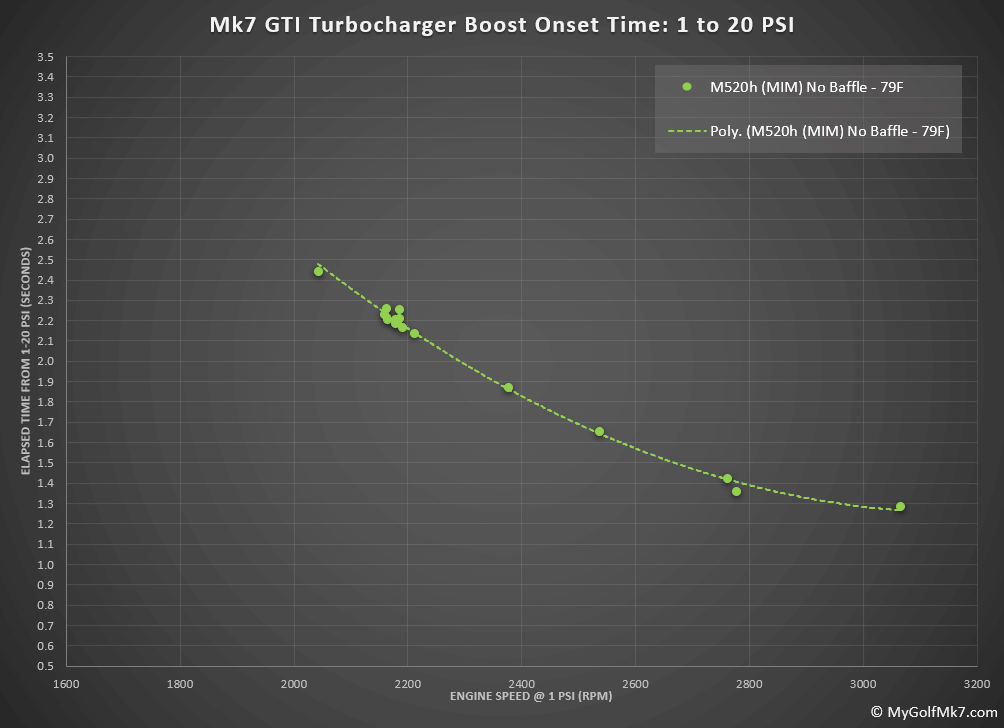Background:
After seeing a video discussing performance benefits of removing the snow guard / air baffle, I decided to test this idea to see if my GTI would show a difference.
Test Discussion:
The test is straightforward: go full throttle in third gear, starting around 2000 to 3000 RPM, and time how long it takes for the boost pressure to increase from 1 psi to 20 psi. This is repeated several times to account for variability and show how the trend varies with starting engine speed.
The snow guard is then added to the air box and the processes is repeated.
The baseline case without the snow guard was repeated to check for consistency, because I suspected that the heating of the intake components might be influencing the results.
Note: I initially discussed this test in the video below and am now adding a post to document the test on the website.
Test Results:
The baseline data without the snow guard /baffle is shown below.

Installing the air baffle corresponds to an increase in the boost onset time, as indicated by the orange symbols.
A recheck was performed without the baffle to determine if heating of the intake might be affecting the boost onset. As indicated by the blue symbols, the warmed intake without the baffle performed similarly to that with the baffle.

Conclusion:
A test was conducted to evaluate the effect of the air intake snow guard/air baffle on the onset of turbocharger boost pressure.
No significant difference was observed with the snow guard installed and when it is removed.

Didn’t you test the stock intake mods for like a 100 times so far? What I still don’t understand from your testing, does the open intake lose power or not? Flow test is only one side of the story.
Hi. I don’t think I’ve done 100 tests with stock intake modifications, but I have done a number of them.
The answer isn’t yes or no since there are different open intake designs, and applications. On the Miscellaneous Tests page, some of the work I’ve done comparing the Open and Closed intakes is linked.
I presume you’re stating that ‘flow test is only one side of the story‘ for the benefit of somebody other than me, as I’ve made over 100 posts on the topic of Temperature Effects, and even this post discusses the effect Temperature can have on performance.
Hi, I appreciate you effort and you gave us much useful information. But sometimes you give so much data without the end result (if you know what I mean). You test pre turbo IAT with open intake without giving info of post turbo IAT which is more useful information. Also, a simple Dragy 100-200kmh test with multiple intakes would tell everything and give the end result.
In the testing of the intake types, and the effect on the pre-turbo air temperature, the ‘end result‘ I was interested in learning about was the effect on pre-turbo air temperature. I do not understand how measuring the post-turbo air temperature, which is a function of the temperature state of the compressor housing, compressor wheel, and operating pressure, would be a better indicator of the effect of the intake type on pre-turbo air temperature.
One thing that recording the time for the car to accelerate from 100-200 kmh would not provide is the air temperature exiting the intake, which is the property I was interested in learning about.
I do in some tests measure vehicle acceleration, as I most recently did two weeks ago in the post about the Mann air filter. Depending on what I am interested in learning I tailor the test to be what I find most appropriate.
Isn’t the temperature of air entering the engine more important? Also, 100-200 test will give you info if the intake is beneficial for the car or not, simple as that.
The air temperature entering the compressor more significantly affects the work the compressor must do to increase air density.
In the 100-200 test of the intakes, how are you distinguishing between pressure effects and temperature effects of the intakes?
Thanks, as always, Jeff!